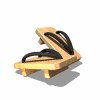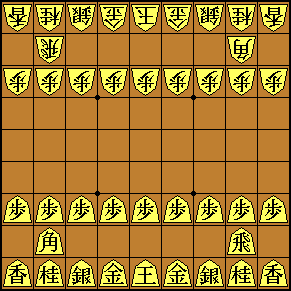

SHOGI (Japanese Chess)


|
Meet local Shogi, Xiang-Qi and Jang-Ki players
every Thursday 6:00 - 8:00 p.m. (18:00 - 20:00 Uhr)
in the Bistro Forum 3
Gymnasiumstr. 21, Stuttgart-Mitte
E-mail: Bernhard Haug
|

|
Shogi is the name of the traditional Japanese version of chess. It is
played on a BOARD of nine-by-nine checks with identical colour
divided by dark lines. The shape of the checks is not exactly square, but
rectangular with the longer side aligned with the axis that joins the two
facing contestants. Thanks to this design, which of course would not make
sense for the electronic version, the checks are perceived as squares if
looked at in an oblique angle from the usual squatting position.
The PIECES are plastic or wooden chequers with 5 corners. Chinese characters
mark the value of the pieces in a similar order of rank as in Western chess.
As by tradition the existence of only one godlike king [oushou] may be
recognized, the other is called jewel general [gyokushou], perhaps representative
of capitalism, and it is always his doubtful privilege to start the battle.
The additional width of the board allows each king [oushou and gyokushou]
to be accompanied by two queens named gold generals [kinshou] on either
side, who move one step in any direction except transverse backwards.  The usual starting positions of Western bishop, knight and rook are occupied
by the characters of
The usual starting positions of Western bishop, knight and rook are occupied
by the characters of
silver general [ginshou],
laurel horse [keima] = (knight) and
incense cart [kyousha] = (lance), respectively,
whose movements are more restricted in comparison to Western chess.
Two additional single officers,
flying cart [hisha] = (rook) to the right and
corner-goer or cross-jump (?) [kakukou, kakugyou] = (bishop)
to the left,
make up the link to the front line of pawns named
infantrymen [fuhyou, hohei].
Only the former two major pieces move at arbitrary unobstructed distance
across the edges or across the intersections, respectively, which explains
the translation as rook and bishop, although their starting position differs
from the one in Western chess. The colour of all 40 pieces is identical
for both parties, only the baseline facing the respective owner allows
the allocation to one or the other. This feature permits captured pieces
to be reused by the opponent instead of making a move, an interesting implementation
of the possibility of deserters or turncoats (I am aware that I
am a bit overdoing it with interpretations). The value of the pieces is
engraved in black on the top side.
A different value in red on the bottom side shows up, when the pieces
are reversed to indicate their optional PROMOTION, when they reach
or make a move within the opponent's camp, the last three ranks on the
opposite side:
flying cart [hisha] = (rook) becomes dragon king [ryuuou], and
corner-goer [kakugyou] = (bishop) becomes dragon horse [ryuuma].
The minor pieces silver general [ginshou], laurel horse [keima] = (knight)
and incense cart [kyousha] = (lance) are simply called promoted pieces
[narigin, narikei and narikyou, respectively]. After promotion they all
move like the gold general, as do the footmen [fuhyou] = (pawn), who are
then called [tokin] = (gold).
The face of the chequers is slightly tilted towards the opponent, again
for reasons of equal parallax and to compensate for the opponent's handicap
to read them upside down.
The directions of move roughly resemble those of ordinary chess, as
do the STRATEGY and the goal to checkmate the king. In unpromoted
pieces, however, the possibility of retreat is more restricted. It is fascinating,
how Japanese moral concepts survive in little details of the game. For
those of you who have installed Japanese fonts, I have included a shift-JIS
file of the KANJI (Chinese characters)
that are used in the game, along with their transcription to hiragana and
translation to English. If you use an original wooden set of pieces, the
kanji will be slightly different in a more old-fashioned handscript style,
but identification should be possible when you consider the characters
on both sides of the pieces.

This is the leading Japanese organization of shogi players. It has published
the rules
of the game with illustrations in English, as well as other
information on tournaments and links to foreign shogi associations.
This is the German Shogi Association, which presents information on the game
and tournaments in German language and provides an extensive list of
English
language links to the game.
This institut is sponsored by the government to promote the diffusion of
knowlegde on Japan among the foreign community. One of its newsletters
was specially devoted to shogi, and includes articles on its history, art,
aesthetics, appeal and fascination. The highly interesting shogi
newsletter comprises 20 pages and can be downloaded as a large
PDF file, which may be printed using Adobe Acrobat Reader version 4.0 or
higher.
Pieter Stouten also maintains an excellent Shogi Site in English language
with links to Shogi computer programmes. My special recommendations encompass
the following sharewares, which can also be downloaded from the primary
sites:
As the name suggests, this is a utility to merely look at previously played
games, after you load a file or enter the moves of both participants manually.
Forbidden moves are automatically blocked. The graphics are appealing,
with Chinese or Roman letters to choose from, and with the actual outline
of the pieces in order to more easily recognise them as yours or your opponent's.
The Shogi board above is a screenshot of the starting position. The programme
runs under Windows 3.11 and Windows 95/98. In case the above link is not working,
you may download the programme from here (download 151 kB).
This is an intelligent computer game, which plays against humans
or can be used to document human against human games. It is primarily designed
for DOS, but can be run in a DOS window under Windows 3.11 or 95/98. Permissible
moves light up when you touch a piece with the mouse cursor. Suggested
moves on demand and take-back option are additional useful features for
beginners. The author claims, that the power of the programme is among
the best of non-Japanese electronic Shogi games, but a major drawback is the lack of graphics (pieces are indicated by international letter symbols).
This collection of modern and ancient Shogi Variants runs under Windows 3.11 or 95/98 and features concise and clearly laid out help screens for the original game (download 381 kB) and all variants (link to details). It combines the virtues of both above mentioned programmes, but using visual basic (VBRun300.DLL), its performance in the play against humans is rather slow with CPUs inferior to pentium. Even experienced players will value its support in playing more ancient and complicated versions on boards of up to 25 by 25 squares with more than 100 different pieces moving or jumping in complicated patterns.
Using Windows 95/98 or Windows 2000, WinShogi can be played on one computer, over a local area network (LAN), or even over the Internet. All games are played in a client/server model. WinShogi (download 204 kB) also supports clients running as spectators, and it provides a computer opponent if desired. At any point during the game you can switch between Japanese Kanji or westernized glyphs as piece names. In addition, colours of pieces may be customized according to white or black, and promoted or un-promoted pieces.
This commercial software is the only Japanese one I have experience with. It runs under Windows 98, 2000 and NT 4.0 of any language version, but only in
the Japanese Windows version the menus will be displayed in readable characters. Still, operation is sufficiently intuitive, if the default setup is used. Except for the installation process, it lacks on-line help screens. Playing strength is said to be among the top ranks of all Shogi programmes. To facilitate the use to non-Japanese, I have translated the menus to English (MS Word 6 document).

Further Asian variants of the Chess family:
Please see this page for more information on the layout, pieces and rules of
and Chess variants in other Asian countries:
.



 The usual starting positions of Western bishop, knight and rook are occupied
by the characters of
The usual starting positions of Western bishop, knight and rook are occupied
by the characters of
![]()
![]()
![]()